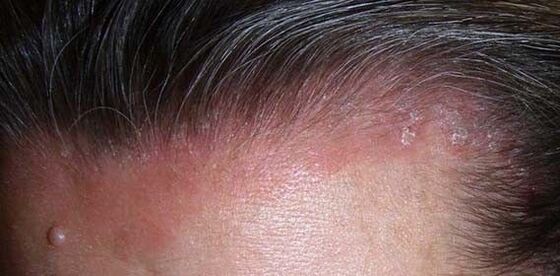
The very first manifestations of psoriasis often appear on the head and then spread throughout the body. Psoriasis of the head is associated with itching and the risk of bacterial complications. If you suspect that the rash is psoriatic, see a doctor immediately - the disease responds well to treatment from the beginning. The article contains all the information about the symptoms associated with this form of the disease and all the known treatments.
Causes of psoriasis on the head
It is a chronic, non-infectious dermatological process that develops in individuals with a hereditary predisposition. The causes and mechanism of psoriasis of the head are not fully understood. But it was found that the process develops in the background of metabolic and immune system disorders. The body loses control over the division of skin cells: they begin to divide much faster. Signs of keratinization appear as quickly as peeling. At the same time, inflammatory processes develop in the skin.
The main cause of scalp psoriasishereditary predisposition. Scientists are trying to identify the genes that are responsible for passing the disease from generation to generation. Separately altered areas associated with different genes in patients and their close relatives have already been developed.
But someone who is genetically predisposed does not necessarily get sick. External and internal predisposing factors are equally important. Scalp psoriasis begins in genetically predisposed individuals due to exposure to the following factors:
- mechanical irritation of the skin (hard toothbrush; damage to small wounds and bark with seborrhea, etc. );
- cold exposure;
- transmitted infectious diseases; often after streptococcal impetigo - purulent rash mainly on the facial skin; develops in children and becomes a stimulant for the development of an autoimmune process;
- chronic stress and high load;
- frequent smoking, alcohol consumption;
- dietary disorders - irregular malnutrition excessive consumption of dry foods, high calorie foods and hot spices;
- hormonal disorders that affect the condition of the sebaceous glands in the skin - obesity, sex hormone imbalance, diabetes, thyroid, pituitary, hypothalamic diseases;
- in liver and kidney disease with impaired function of these organs; toxins are neutralized in the liver and excreted through the kidneys; poisoning can become the starting point for the development of the disease.
One or more factors interrupt the body's interaction with the environment. Protein, fat and carbohydrate metabolism is disrupted, which causes the skin's metabolic processes to speed up and exfoliate.
Psoriasis of any localization can spread throughout the body, so do not delay treatment.
Changes in the immune system are manifested in an increased sensitivity of the skin to any external effects (in addition to combing or frequent hair dyeing). In response to such effects, antibodies are produced against their own cells, triggering an autoimmune inflammatory process. The causes of inflammation are not yet fully understood. This is one of the priorities in the treatment of psoriasis.
Symptoms of psoriasis of the scalp
Psoriasis of the head manifests itself in the form of characteristic symptoms. The disease can start acutely with multiple rashes (a vulgar form of psoriasis) or gradually with itching and peeling of the skin, and only then do you get characteristic rashes (a form of seborrhoea).
It is more common in the form of gradual dandruff and peeling. In the early stages, these are small areas in the occipital region. Exfoliation spreads to larger areas and itching begins. Continuous scratching of the skin contributes to the roughening of the skin and the appearance of abrasions. What Does Scalp Psoriasis Look Like? In the picture, the initial symptoms of psoriasis on the head look like this:
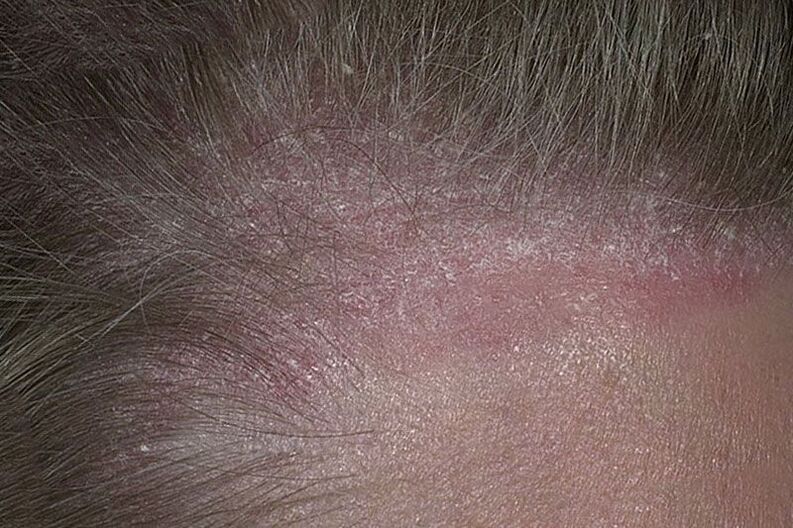
In the area of scratches and abrasions, redness appears first, followed by small inflammatory lumps and papules surrounded by a glossy rim rising above the surface of the skin. Accompanied by severe itching, the rashes increase in size and merge with each other. The characteristics of the rash are as follows:
- white "shavings" covering the papules; scraped resembles a stearin stain; in the seborrheic form, the scales are yellowish and the phenomenon of stearinfol is less pronounced;
- scraping off all the "chips" opens a smooth translucent surface;
- Further scraping leads to the appearance of blood droplets on the surface - "dew".
The three signs in the picture look like this:
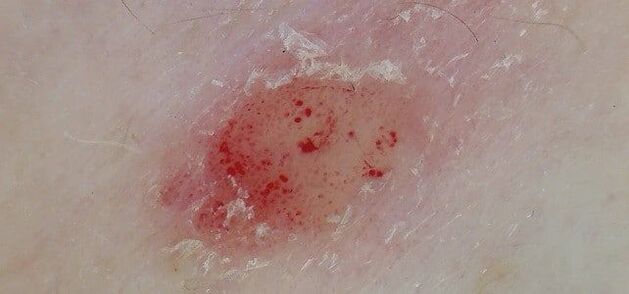
These three characteristic manifestations distinguish scalp psoriasis from seborrheic dermatitis, which can be easily confused. In the future, the papules will merge to form psoriatic plaques that have different configurations and sometimes spread over the entire surface of the head.
The course of psoriasis of the scalp may be mild, with initial rashes in the initial stage. These rashes then go through all three stages of development. In severe form, the rash occupies a significant area and spreads to the face and neck in the form of a crown - an inflammatory rim covered with silvery scales. Hair roots do not suffer, but the psoriatic process is often accompanied by a bacterial, fungal, or mixed infection, leading to less easily treatable complications. This is what the crown looks like:
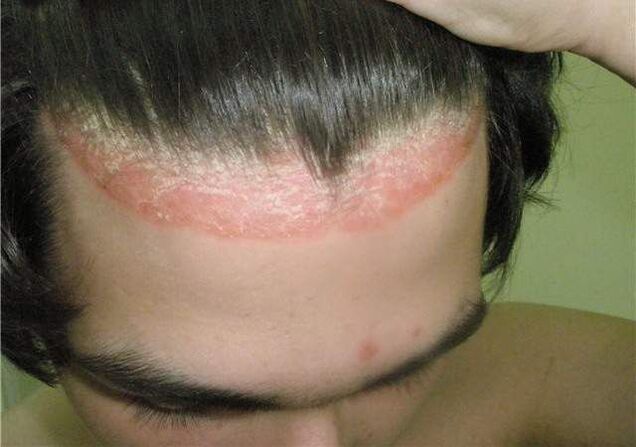
Stages of psoriasis on the head
The disease lasts for a long time, the exacerbations being replaced by remission. The frequency of exacerbations and the severity of symptoms depend on the presence of provocative factors.
Progressive stage
The rash and inflammation spread with intense itching. In the initial stage, a symptom of Koebner is the appearance of psoriasis rashes at the site of scratches and abrasions.
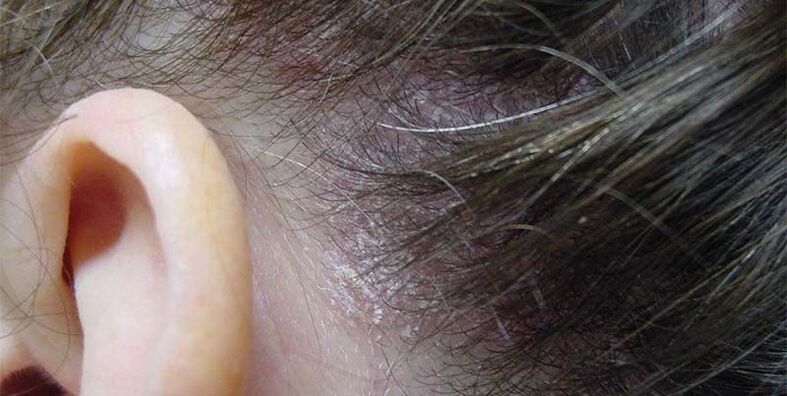
Stationary
The process is in the same state, not spreading, but not fading.
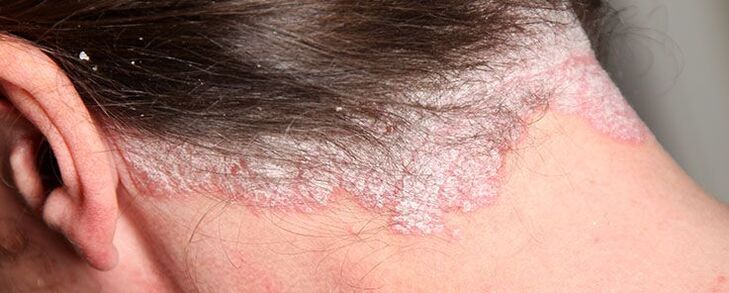
Decreasing
The process gradually subsides, the itching disappears, the rash fades, and the inflammatory infiltration decreases, gradually giving it a patchy appearance; the color of the rash becomes pale from the center, forming ring-shaped shapes with lighter edges. Sometimes they begin to pale from the periphery to the center and then wear whitish rings (one of the symptoms of psoriasis on the head is Voronov’s pseudoatrophy). The healing phase can take quite a long time and gradually only white depigmented spots remain on the skin.
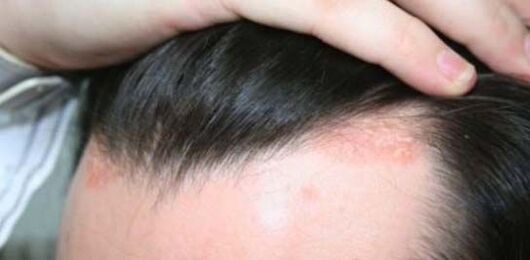
Methods of treating psoriasis on the head
Scalp psoriasis requires systematic treatment under medical supervision. A mobile lifestyle, quitting smoking and alcohol, and weight loss are crucial. It is necessary to treat the disease in a complex way, to apply techniques that take into account the specifics of the patient's body. Complex therapy can include modern European methods, medication, and centuries-old Eastern methods. Such treatment can immediately significantly improve the patient's condition and lead to stable remission within a few weeks.
PRP therapy - the method is based on the ability of the platelets (red blood cells) to select a growth factor that stimulates the cells to regenerate. By centrifugation, the patient's blood is enriched with platelets and then injected sharply into the scalp. The technique can significantly accelerate the onset of remission and prevent relapses from occurring.
Autochemotherapy - treatment is given by injecting a small amount of blood from a patient's vein into a muscle. This has a general stimulating effect, restoring the epidermis of the head. Stable remission is observed after treatment.
Reflexology is the effect on specific points in the body in a variety of ways that are reflexively connected to organs and tissues. One of the oldest and most effective traditional treatment methods. The effect on the points can be determined by acupuncture (acupuncture), cauterization, massage, etc. The treatment of psoriasis of the head with these methods has been used by Eastern medicine for thousands of years. The treatments are performed by a reflexologist.
Vacuum therapy - the effect of sparse air on biologically active points - is a method of reflexology. Can be done with cans or special equipment. Facilitates rapid recovery of altered tissues. As a result of the application of vacuum therapy, the affected areas are significantly reduced.
Phytotherapy - Dermatologists make extensive use of herbs in their practice in the form of infusions, decoctions and finished dosage forms. Used properly as part of a complex treatment, they are very effective in both the early stages and long-term forms of the disease. Adding phytotherapy increases the effectiveness of other treatments and reduces the risk of developing side effects.
Treatment of psoriasis on the head in the clinic
In a specialized clinic, this disease is treated by dermatologists who have trained and clinical experience in the treatment of the disease using all currently known methods. In their work, they use new Western medical treatment methods combined with traditional Eastern methods that have been successfully used by doctors in ancient China and Tibet for millennia.
The cause of the disease must be eliminated to prevent relapse
Professional clinics use a variety of methods, with an individual approach to each patient. Many complex methods combined with medication can permanently save a patient from scalp problems.
The effectiveness of the treatment in the clinic is noted in their comments and evaluations not only by patients receiving regular supportive care, but also by colleagues from other Moscow clinics.
Prevention of psoriasis of the head
Prevention of psoriasis of the head is especially important for people with hereditary predispositions who have sick relatives. This includes eliminating the effects of the following factors:
- any prolonged skin contact;
- malnutrition and sedentary lifestyle;
- prolonged stress and heavy strain;
- smoking and alcohol consumption;
- hormonal disorders - if such disorders are suspected, consult an endocrinologist immediately;
- poisoning - all chronic diseases that contribute to metabolic and immune impairment should be treated in a timely manner.
The dermatologist can tell you how to treat psoriasis on your head after an examination. Therefore, you should not delay the advice of a specialist because the initial stages of the disease are much easier to treat. Can we cure this process? It is completely impossible to cure the disease, but if a person is treated regularly, there is a great chance of getting rid of relapses for a long time.
Diet for head psoriasis?
There is no special diet, but the treatment for scalp psoriasis consists of 4 proper meals a day that contain all the ingredients needed by the body. Foods that irritate the skin must not be on the table:
- spicy, salty, sour;
- fruits rich in essential oils (fresh garlic and onion, radish);
- fried, smoked, canned food;
- caffeinated beverages - strong tea, coffee, coca-cola, etc. ;
- alcoholic beverages - contribute to the relapse of the disease.
It has been found that meat foods cause aggravation, so the diet should include foods high in complex carbohydrates, lean meats, cottage cheese, yogurt, and so on. must contain.
Medication therapy for psoriasis of the scalp?
Medications are selected according to the patient's condition and the presence of certain symptoms of the disease. The following external agents are used in the initial stages of psoriasis of the head:
- if wet, prescribe solutions and creams that eliminate these symptoms and prevent bacterial and fungal infections;
- if the skin is dry, treat it with ointments; ointment with salicylic acid - has a emollient effect; tar ointments have the same effect; ointments with zinc and an analogue of vitamin D3 + glucocorticoid betamethasone help a lot - it helps to quickly eliminate the symptoms of psoriasis;
- ointments and creams containing corticosteroid hormones are prescribed to treat common forms of psoriasis on the head;
- shampoos are widely used; so tar shampoos relieve inflammation, soften the bark; zinc-containing shampoo has a disinfectant and emollient effect, relieves inflammation; shampoos have long been used.
Folk remedies for psoriasis?
Is It Possible To Treat Scalp Psoriasis With Folk Remedies? Most professionals use folk remedies to treat the disease symptomatically (to relieve certain symptoms). But you need to make it clear that:
- the disease should be treated with folk remedies as recommended by a dermatologist;
- it is impossible to cure the disease by folk remedies alone; dermatologists prescribe complex therapy in combination with traditional medicine.























